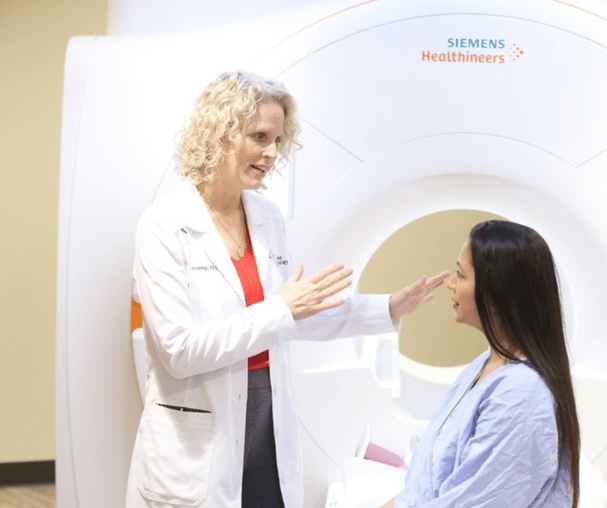
Radiation comes in many forms, and we’re exposed to it every day. At low levels, radiation exposure is not a cause for concern; it’s simply a fact of life. Exposure to high levels of radiation, on the other hand, can cause severe health effects and even death. When you’re considering a medical procedure that involves radiation, it makes sense to weigh the potential risk to your health against the benefit it can provide. Let’s look at what you should know about radiation in mammograms.
Modern mammograms use a very small amount of radiation.
We can measure the amount of radiation a person receives in millisieverts (mSv). The U.S. Department of Energy estimates that Americans receive an average of 6.2 mSv of radiation per year, approximately half of it coming from natural sources like the sun and soil. We’re exposed to more radiation at higher elevations, where the atmosphere provides less protection from cosmic rays. For example, a three-hour plane ride delivers about 0.1 mSv.
A typical screening mammogram uses 0.4 mSv of radiation, and modern 3-D mammograms often use even less. C-View low-dose 3-D mammography, for example, delivers just 1.45 mSv. This is less than half the amount of radiation you’re likely to absorb from natural sources in the environment over the course of a single year.
Low radiation doses are not associated with negative health effects.
While medical imaging providers always err on the side of caution by keeping radiation doses “as low as reasonably achievable” (ALARA), the evidence doesn’t support the notion that low levels of radiation exposure increase one’s cancer risk. Studies of people who have been exposed to radiation through medical imaging, occupational exposure, and increased environmental exposure have found increased cancer risk associated only with doses above 100 mSv. In fact, many researchers cite evidence that low doses of ionizing radiation may provide some protection against cancer, a phenomenon known as hormesis.
Exams that don’t use radiation are not a substitute for mammography screening.
While mammography uses X-rays to produce images, there are other breast imaging exams that don’t use radiation. The FDA issued a warning last year about thermography, which uses an infrared camera to show patterns of heat in the body. Some health spas and alternative health clinics had been promoting this technology as a method of breast cancer screening, but the FDA stated that, “There is no valid scientific data to demonstrate that thermography devices…are an effective screening tool for any medical condition including the early detection of breast cancer."
Ultrasound is often used in breast cancer screening, but not as a standalone tool. It’s most often used as a follow-up exam to obtain additional information about suspicious features found on a mammogram. Likewise, breast MRI is often used as a supplementary screening tool for women who have an elevated risk of breast cancer. Abbreviated breast MRI is an exciting new screening method that helps radiologists find hard-to-detect cancers in women with dense breast tissue who don’t have an elevated cancer risk. Despite the high sensitivity of MRI exams, however, women who receive them are still advised to undergo mammography for primary breast cancer screening.
Annual mammography for women 40 and older saves lives.
The American College of Radiology (ACR), the Society of Breast Imaging and the American College of Obstetricians and Gynecologists agree: mammography prevents cancer deaths, and annual screening beginning at age 40 saves the most lives. A study recently published in The Lancet Oncology supports this, finding that among more than 160,000 women who were enrolled in the study between the ages of 39 and 41, annual mammography resulted in a significant reduction in breast cancer mortality over the following ten years. The ACR estimates that since 1990, mammography has helped to reduce deaths from breast cancer by 40%. Because mammography screening prevents cancer deaths, exposure to a small dose of radiation is no reason to skip your mammogram.
Iowa Radiology is proud to be an ACR-designated Breast Imaging Center of Excellence. We provide cutting-edge breast imaging services, including 3-D mammography, high-risk and abbreviated breast MRI, breast ultrasound, and imaging-guided biopsy. Feel free to access any of the resources below for more information.
Resources
ACR, SBI support updated ACOG recommendations that women begin annual mammograms at age 40. MedicalXpress. https://medicalxpress.com/news/2011-07-acr-sbi-acog-women-annual.html. Published July 20, 2011. Accessed October 6, 2020.
Duffy SW, Vulkan D, Cuckle H, et al. Effect of mammographic screening from age 40 years on breast cancer mortality (UK Age trial): final results of a randomised, controlled trial. Lancet Oncol 2020;21(9):1165–1172. http://doi.org/10.1016/S1470-2045(20)30398-3. Accessed October 6, 2020.
Kaminski CY, Dattoli M, Kaminski JM. Replacing LNT: The Integrated LNT-Hormesis Model. Dose-Response. April 2020. http://dx.doi.org/10.1177/1559325820913788#articleCitationDownloadContainer. Accessed October 6, 2020.
Mammogram Basics. Cancer.org. https://www.cancer.org/cancer/breast-cancer/screening-tests-and-early-detection/mammograms/mammogram-basics.html. Revised March 5, 2020. Accessed October 6, 2020.
Mammography Saves Lives. Accreditation.org. https://www.acraccreditation.org/mammography-saves-lives. Published December 19. 2018. Accessed October 6, 2020.
McCollough CH. Radiation Risk from Medical Imaging. Mayo.edu. https://www.mayo.edu/research/documents/radiation-risk-from-medical-imaging/doc-20156687. Published May 15, 2015. Accessed October 6, 2020.



